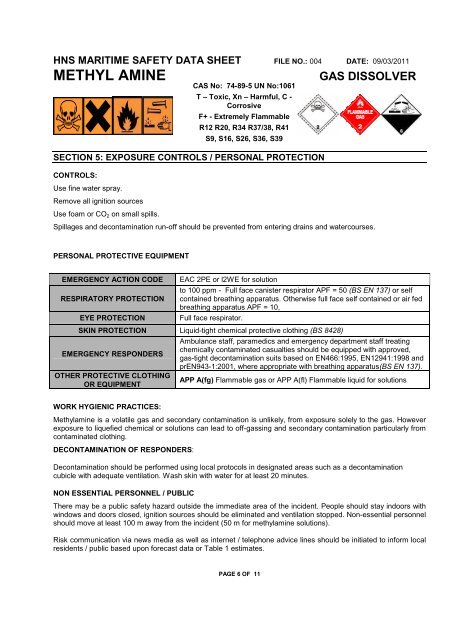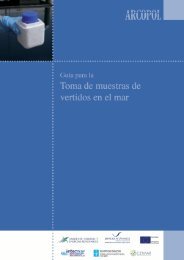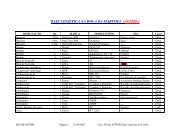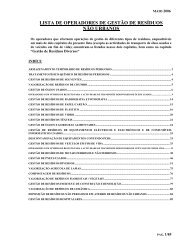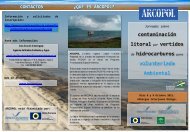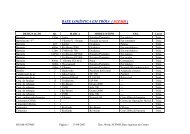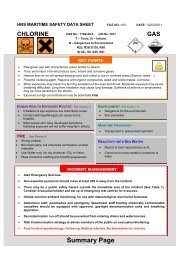methyl amine gas dissolver - Arcopol.eu
methyl amine gas dissolver - Arcopol.eu
methyl amine gas dissolver - Arcopol.eu
You also want an ePaper? Increase the reach of your titles
YUMPU automatically turns print PDFs into web optimized ePapers that Google loves.
HNS MARITIME SAFETY DATA SHEET FILE NO.: 004 DATE: 09/03/2011<br />
METHYL AMINE<br />
CAS No: 74-89-5 UN No:1061<br />
T – Toxic, Xn – Harmful, C -<br />
Corrosive<br />
F+ - Extremely Flammable<br />
R12 R20, R34 R37/38, R41<br />
S9, S16, S26, S36, S39<br />
SECTION 5: EXPOSURE CONTROLS / PERSONAL PROTECTION<br />
CONTROLS:<br />
Use fine water spray.<br />
Remove all ignition sources<br />
Use foam or CO 2 on small spills.<br />
GAS DISSOLVER<br />
Spillages and decontamination run-off should be prevented from entering drains and watercourses.<br />
PERSONAL PROTECTIVE EQUIPMENT<br />
EMERGENCY ACTION CODE<br />
RESPIRATORY PROTECTION<br />
EYE PROTECTION<br />
EAC 2PE or l2WE for solution<br />
to 100 ppm - Full face canister respirator APF = 50 (BS EN 137) or self<br />
contained breathing apparatus. Otherwise full face self contained or air fed<br />
breathing apparatus APF = 10,<br />
Full face respirator.<br />
SKIN PROTECTION Liquid-tight chemical protective clothing (BS 8428)<br />
EMERGENCY RESPONDERS<br />
OTHER PROTECTIVE CLOTHING<br />
OR EQUIPMENT<br />
Ambulance staff, paramedics and emergency department staff treating<br />
chemically contaminated casualties should be equipped with approved,<br />
<strong>gas</strong>-tight decontamination suits based on EN466:1995, EN12941:1998 and<br />
prEN943-1:2001, where appropriate with breathing apparatus(BS EN 137).<br />
APP A(fg) Flammable <strong>gas</strong> or APP A(fl) Flammable liquid for solutions<br />
WORK HYGIENIC PRACTICES:<br />
Methyl<strong>amine</strong> is a volatile <strong>gas</strong> and secondary contamination is unlikely, from exposure solely to the <strong>gas</strong>. However<br />
exposure to liquefied chemical or solutions can lead to off-<strong>gas</strong>sing and secondary contamination particularly from<br />
contaminated clothing.<br />
DECONTAMINATION OF RESPONDERS:<br />
Decontamination should be performed using local protocols in designated areas such as a decontamination<br />
cubicle with adequate ventilation. Wash skin with water for at least 20 minutes.<br />
NON ESSENTIAL PERSONNEL / PUBLIC<br />
There may be a public safety hazard outside the immediate area of the incident. People should stay indoors with<br />
windows and doors closed, ignition sources should be eliminated and ventilation stopped. Non-essential personnel<br />
should move at least 100 m away from the incident (50 m for <strong>methyl</strong><strong>amine</strong> solutions).<br />
Risk communication via news media as well as internet / telephone advice lines should be initiated to inform local<br />
residents / public based upon forecast data or Table 1 estimates.<br />
PAGE 6 OF 11


